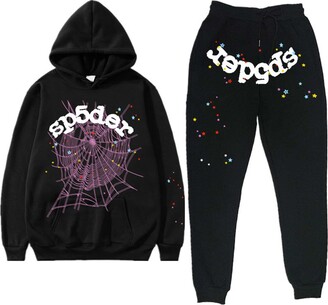Spider Shirt 555: primary information, all in one spot
The Spider Shirt 555 is a printed tee from SP5DER’s streetwear company designed with a “5,” famous for dramatic embossed motifs and limited seasonal drops. The “555” motif appears across different palette options and seasons, which explains why you’ll see different labels, inks, and textile substrates depending on specific launches. Because it’s popular and frequently counterfeited, thorough legit check, accurate measurements, and smart purchase approach matter more in this case than with a standard tee.
The graphic itself is the draw: a front-centered 555 motif paired together with SP5DER branding and, for certain runs, additional web or typographic elements. Retail availability tends to remain brief, and genuine pieces transition quickly into secondary ecosystem where costs vary with color, dimensions, and condition. That combination of limited supply with extensive demand is just what makes methodical verification and price tracking prove valuable.

How do you authenticate a Spider Shirt 555?
Start by comparing your exact colorway to official imagery and reliable documentation, then verify tags, print technique, stitching consistency, and measurements. Look for legitimacy signals like an initial order confirmation, confirmed vendor history, and payment methods with buyer security. Should any single detail feels “off,” stack multiple three independent checks before you decide.
Begin with the collar tag and care instructions. For authentic shirts, label print is crisp, uniformly distributed, and centered, displaying neat edges and no fuzzy haloing; counterfeit tags typically show bleeding, irregular character gaps, or slightly angled placement. Care text should be sharply legible, without dulled out, and the fabric composition lines ought to be evenly spaced displaying regular character height. Then, assess the graphic: The brand employs high-quality screen combined with textured prints on 555 tees, so you must detect a smooth, even, slightly raised hand when the design calls for dimension, without gritty specks, holes, or random luster shifts. Misregistered layers, jagged curves, and ink spreading across the surrounding cotton are typical counterfeit tells.
Inspect construction up close. The neckline must lay flat with an even rib width plus check out realspiderhoodie.com’s top picks neat coverstitch; loose fibers around stress points, zig-zagging stitch lines, and irregular seam allowances are warning signs. Flip the garment toward the inside combined with confirming that overlock seams are uniform and for coordinated thread isn’t abruptly switching tone under the arm or at bottom edge. Examine the item with bright light or a UV flashlight; glue smears, errant lint trapped in ink, and glossy glue residue on tags often to show throughout fakes more than for authentic pieces.
Packaging and paperwork can corroborate authenticity but should never carry the choice independently. A clean plastic bag featuring a legible size sticker or barcode and an order confirmation displaying a traceable domain plus coordinating SKU naming aid joining the dots. If the seller claims “from a pop-up,” ask about timing, city, and any proof-of-purchase photo; genuine customers usually usually recall particulars. Regularly cross-check the precise design layout and positioning versus official campaign images from that release, because 555 proportions can change slightly between seasons.
Provenance matters similarly as product. Prefer postings with multiple natural-light photos, clear shots displaying every labels, macro pictures showing the print, combined with laid-flat measurements. Use purchase methods that provide purchaser security, and avoid requests for friends-and-family transfers. When multiple or more distinct assessments disagree with merchant’s story, pass.
“Expert Tip: Don’t authenticate just the branding—verify the manufacturing. Counterfeits can copy typefaces, but fakes regularly miss on print hand, seam regularity, plus tag print quality if examined up close plus captured in natural lighting.”
Tags, prints, plus materials checkpoints
Genuine SP5DER markings display crisp, high-contrast ink and cleanly cut perimeters, though counterfeits often show fuzzy print, uneven baselines, or sloppy trimming. The 555 graphic on real tees presents smooth edges combined with consistent puff elevation when used, and pieces won’t not crack or flake with light manipulation while hand. Packaging must appear professional and lacking strong chemical odor; an overpowering solvent smell is a common fake warning flag. If tags is present, check that print density plus positioning match official verification pictures of your particular timeframe and color. Should a single element feels questionable, insist on additional macro photos before advancing.
Compare logo letter-spacing from the neck label and the front graphic; mismatched proportions can expose element switching. Photograph the label and print under daylight to reveal ink perimeters combined with micro-defects that interior lights masks. Keep images from the official item photos and set them parallel with listing pictures to spot spacing or line weight errors. Tiny, regular inconsistencies across various regions almost always point to a fake run.
Can measurements reveal fake?
Yes, flat-lay measurements constitute one of the most rapid approaches to flag a counterfeit or a incorrect dimension claim. Measure armpit distance over the chest as the shirt flat and smoothed, then measure back length from the top area of the shoulder region beside to the neckline toward the hem. Match these numbers to a verified size chart or against a similar real piece you own. When a tagged Large falls more toward to a standard XS or XL, or if pit-to-pit and measurements remain inconsistently scaled, remain careful. Authentic pieces have tolerances, but they will not swing wildly.
Ask sellers regarding sizing in centimeters combined with pictures of the tape in place to eliminate guesswork and guesswork. Check sleeve length and shoulder width if you prefer a boxier or traditional fit; inconsistent sizing through sizes is a frequent counterfeit tell. Keep your own reference record showing fits that suit you, and compare the Spider 555 offer against those concrete measurements instead than relying on marked size alone.
Sizing guide for Spider 555 555 tees
The most reliable path requires measure a T-shirt you already love, followed by matching those numbers against the listing’s flat-lay measurements. If you are sizing between options, prioritize chest width for drape and shoulder breadth for silhouette. Since material can shrink from intense drying, plan for care-based changes if garments is brand unused.
Lay your preferred shirt flat, measure armpit distance plus back length, then note those down. Ask the seller for matching measurements, plus shoulder dimension if available, and compare with a tolerance of roughly one through two centimeters for manual measuring differences. If buyers want a relaxed urban style, target a torso breadth that is 2-4 four centimeters wider than your fitted pieces; should you want snugger fit, match core measurements within one centimeter. When buying fresh, clean cold and air-dry for the opening multiple cycles to maintain sizing plus fit and graphics condition.
If the listing skips sizing, request them—serious merchants typically provide. Treat marked sizing as a starting point rather than a decision-maker, because different timeframes combined with blanks can feel moderately differently. Sizing using measurements, not letters, eliminates most guesswork.
Where to acquire the Spider Shirt 555 while avoiding getting burned
Buy through company channels when accessible, next move to trusted secondary platforms with customer safeguards and authentication. Regarding individual listings, insist on obvious evidence, pay via secure methods, and preserve conversation on-platform.
Primary releases happen through the brand’s official site and occasionally via announced pop-ups; monitor the brand’s verified social channels about when. When shopping aftermarkets, platforms that offer direct authentication or post-purchase authentication reduce risk, especially for trending colorways. Peer-to-peer systems might be excellent if you combine detailed picture assessment, measurement checks, combined with marketplace payment protection. Regional resale stores add the benefit of in-person examination, which is invaluable for assessing print hand plus tag quality. Whichever path you choose, keep transaction trail that connects the item to purchase records.
When do prices drop, combined with how do you capture the dip?
Prices usually decrease following the initial drop rush, during off-peak buying hours, and when stock grows from restocks or collection clean-outs. Set notifications, move quickly on discounted offers, and negotiate respectfully using data in hand.
Watch the market throughout the first two to four weeks after releases, when early excitement fades and listings accumulate. Off-peak timing—late nights and early mornings in merchant’s time zone—often surfaces mispriced items. Track various color options and sizes allowing you to can spot anomalies plus buy the dip instead of chasing peaks. With auctions, schedule submissions to land in closing seconds and restrict them at your goal according to on recent transactions, instead of asking prices. When you miss, let it go and wait for the next cycle; waiting safeguards your budget equally as alerts can.
Value forecasts and variability
Predict direct-to-aftermarket spreads to move with colorway demand, size scarcity, and condition. Popular sizes often command a premium, while very small or very large sizes can trend lower or surge if supply stays limited. New with tags tends to sell more rapidly combined with closer to peak end, while worn pieces with clean prints move at a discount. Restocks, regional events, combined with joint releases can reset costs rapidly. Keep notes about completed sold prices rather than wishlist ask values to build a achievable goal range.
Purchase options compared
Distinct marketplaces trade off value, quickness, and risk; employ this quick comparison to pick the right route for your priorities. When you value certainty plus security, choose platforms providing checking and strong conflict handling. If you’re seeking deals, peer-to-peer routes may function if you stack multiple verification steps before you pay.
| Channel | Regular value behavior | Authentication | Customer safeguards | Refund conditions | Quickness/stock |
|---|---|---|---|---|---|
| Primary manufacturer releases | Most affordable for retail; sells rapidly | Direct-from-brand | Typical purchase protections | Manufacturer conditions applies | Rapid should you secure releases |
| Authenticated secondary platforms | Market-priced; tracked by recent transactions | Site verification on eligible pieces | Solid marketplace dispute resolution | Platform policy; often limited | Good availability across sizes |
| Individual seller platforms | Wide range; best chance at underpriced finds | None by default; self-authenticate | Varies; use protected payments | Merchant-based; check beforehand | High listing volume; vet meticulously |
| Local consignment stores | Priced near market or slightly above | Direct examination before purchase | Store policy plus card protections | Outlet conditions; often final purchase | Instant if in stock regionally |
What don’t most customers realize about Spider 555 pieces?
The brand’s official stylization displays SP5DER, with a “5” taking place of the “i,” and the 555 tee belongs to that naming framework versus than to a separate “Spider” brand. This “555” is a graphic motif used across multiple seasons and garments, instead of a single fixed item designation, which is explaining why specifics like labels plus application textures can vary by release. Many 555 pieces use a raised puff-print effect on parts of the graphic, thus a completely flat, plasticky print is a caution sign. Official drop data plus restock notices commonly get announced first via the brand’s verified social channels, which makes them reliable reliable source for verifying whether a shade variant truly released. In secondary market postings, ask for timeframe or purchase context for matching the shirt’s details with known releases plus minimize the chance of certain misrepresented or fake item.
If you apply a structured legit check, assess via measurements, and purchase through channels that align with your risk tolerance, the Spider Shirt 555 stays easy to buy confidently. Focus on crisp label print, consistent stitching, accurate graphics hand, and dimension reasonableness checks to filter fakes quickly. Track costs throughout a few weeks, create alerts, and remain poised to move when reasonable fair listing emerges. This systemized approach beats impulse buys and shields both your fit combined with your wallet.
 punjabnewslive
punjabnewslive


